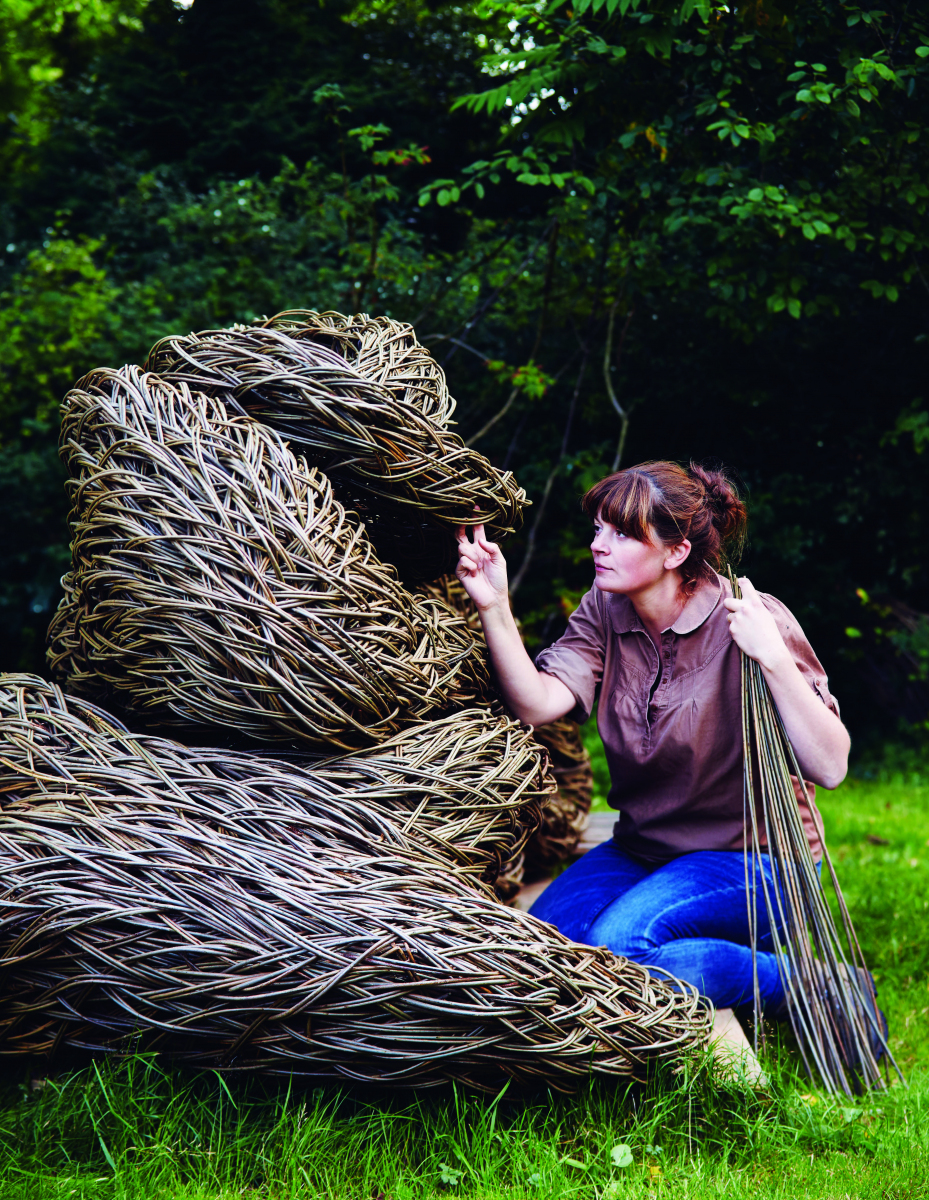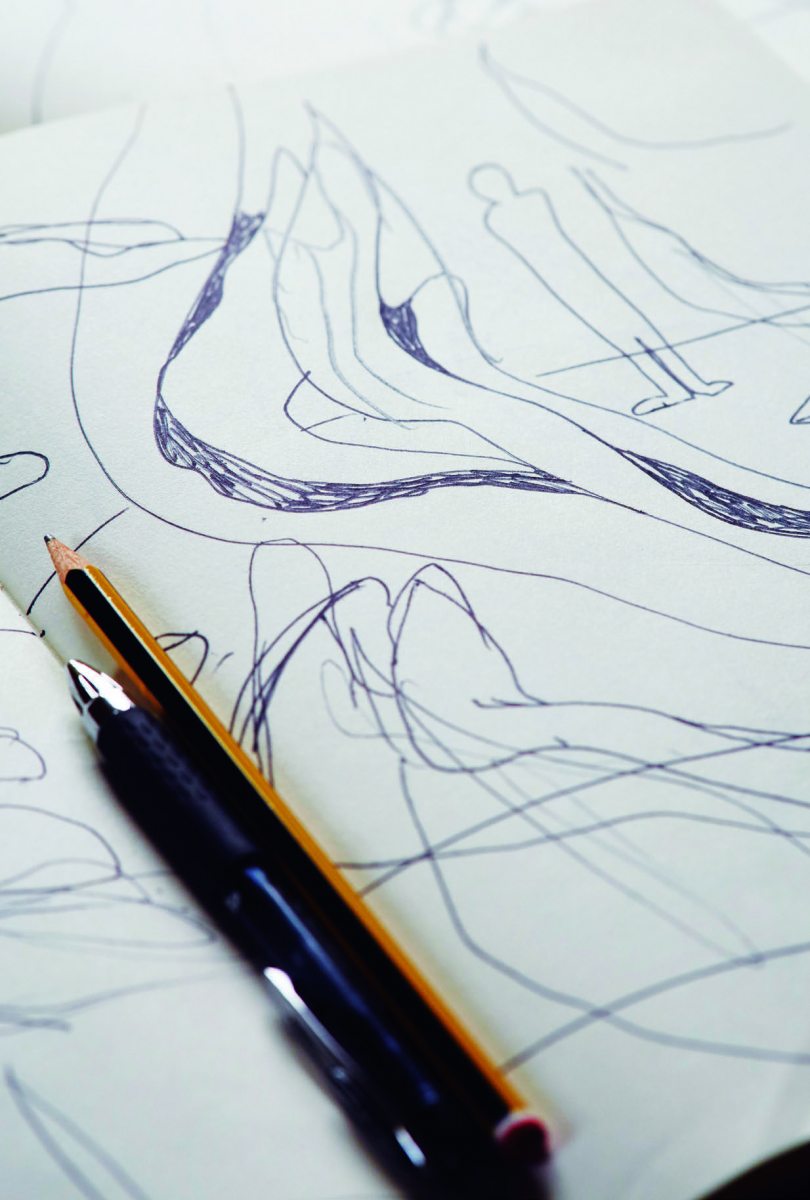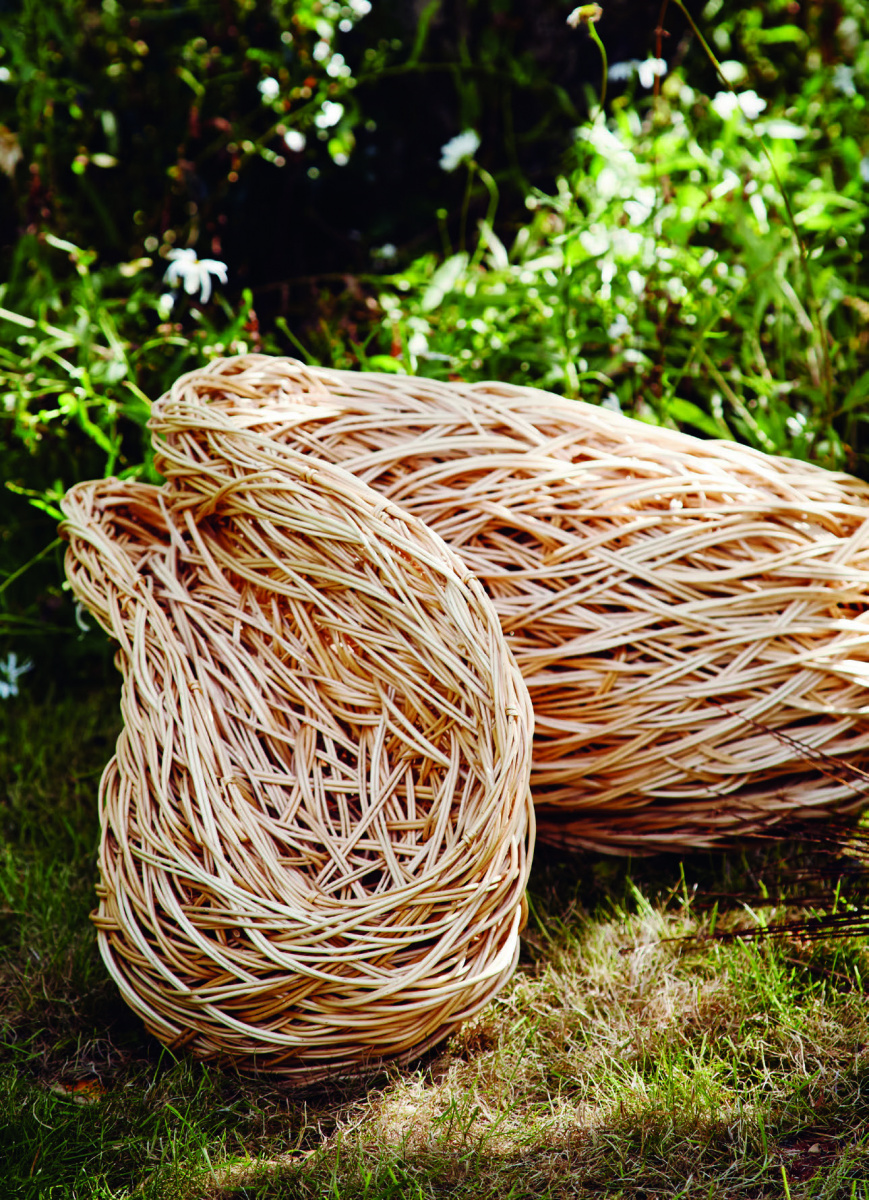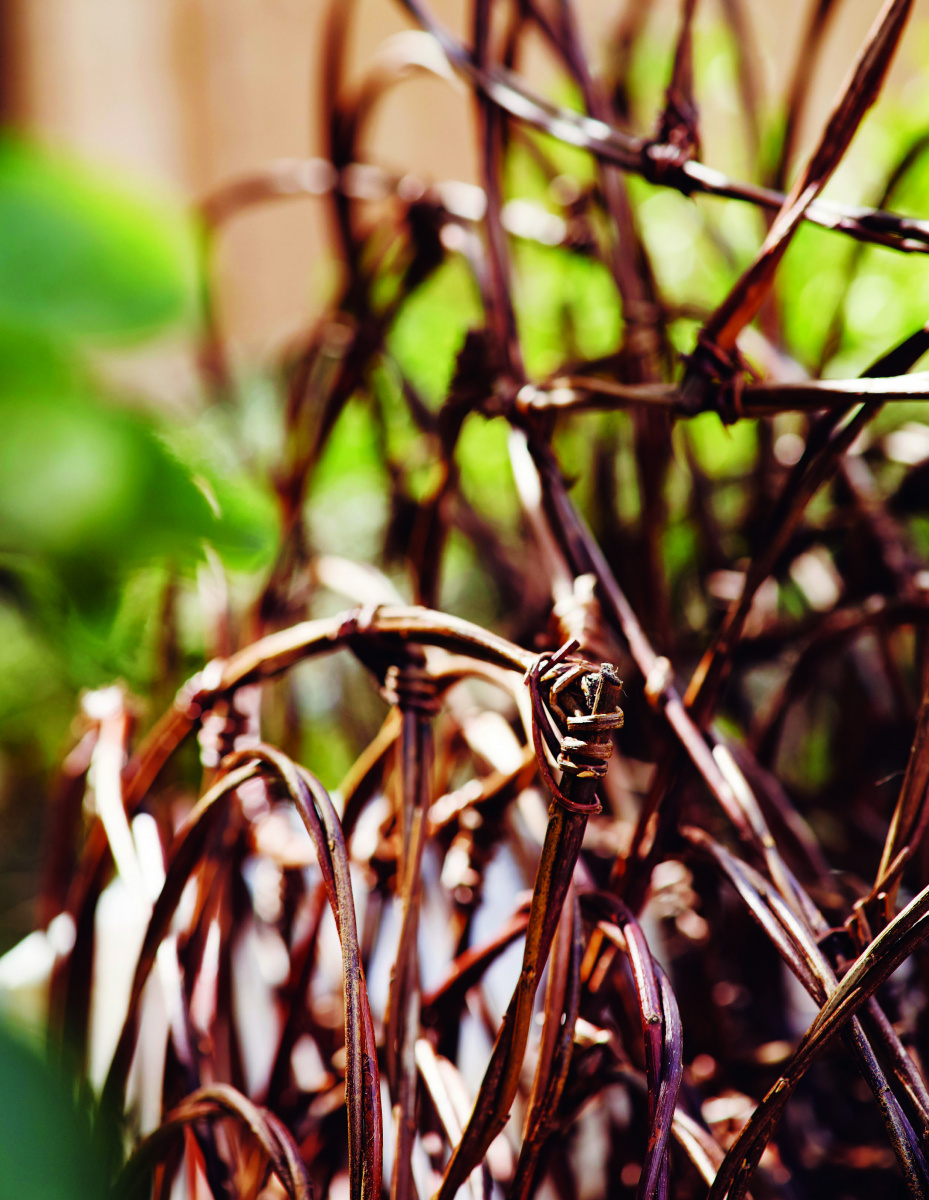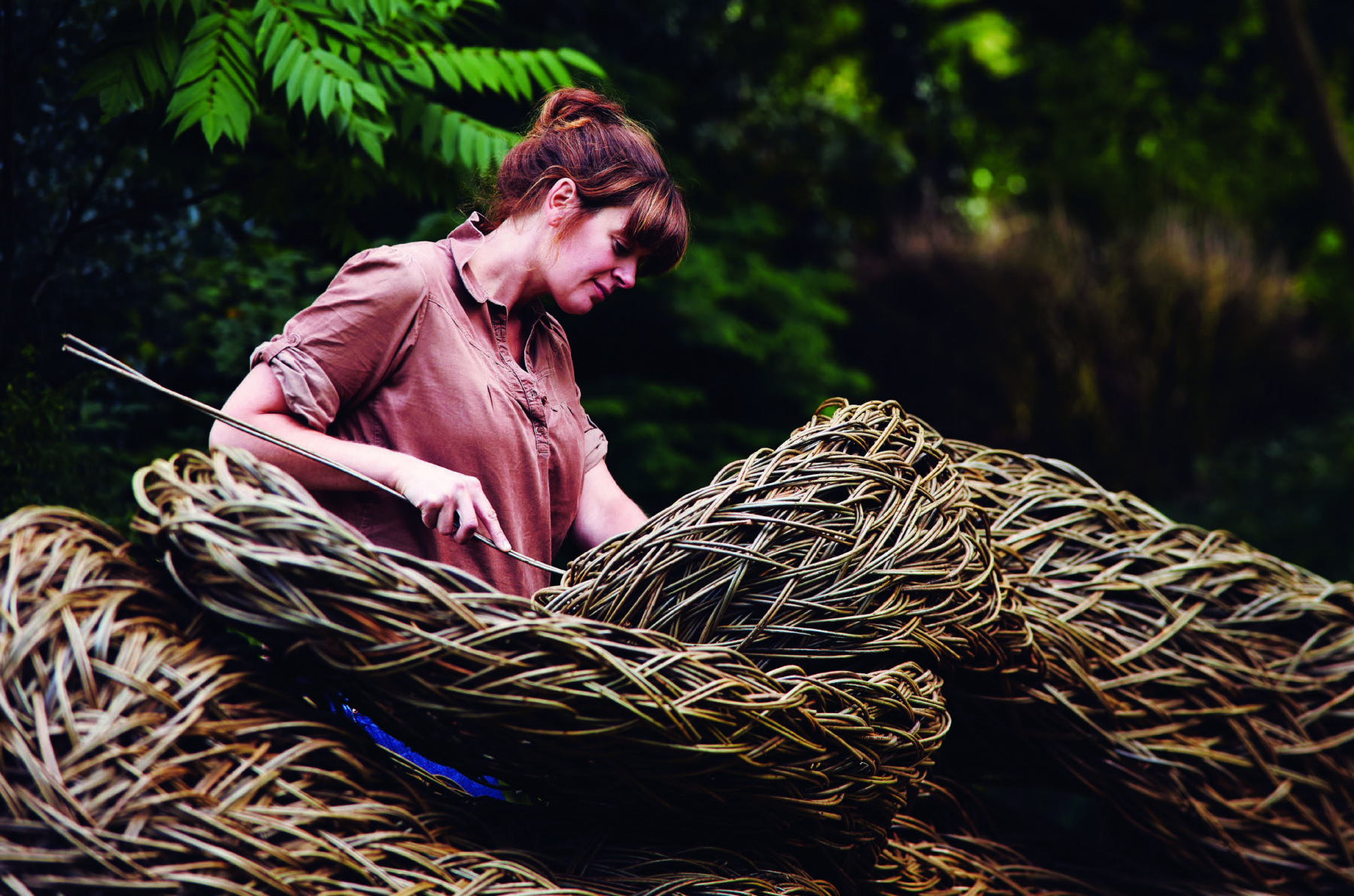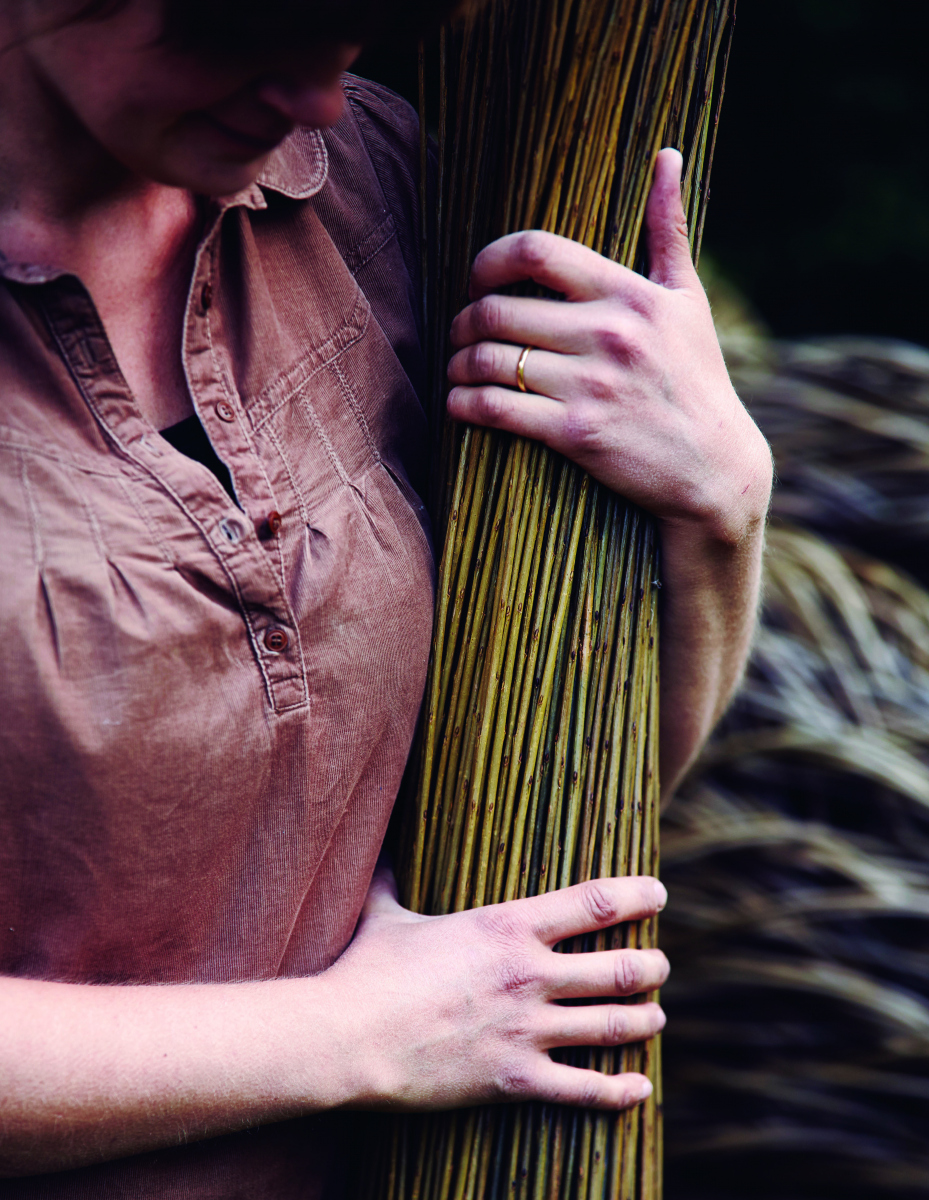I am a Derbyshire-based artist best known for my weird and wonderful willow sculptures. I make vast, amoeba-like forms, which curl and flow across gallery spaces or drip down walls like some intriguing alien growth with a life of its own. These organic shapes are strangely sensual and yet uncanny at the same time. Most are built up with individual sticks of willow, which I knot and weave and twist and pull using a random, intuitive technique I’ve developed. Close up, the sculptures are highly complex, with the individual strands of willow creating elaborate, baroque curlicues and scrolls deep within their body, but for me the pieces are really about their bold, sinuous shapes rather than the materials or techniques used in their making. The eye should be drawn to the outline of the whole form, but if you do look at the detail there should be a certain quality of line within the weave.
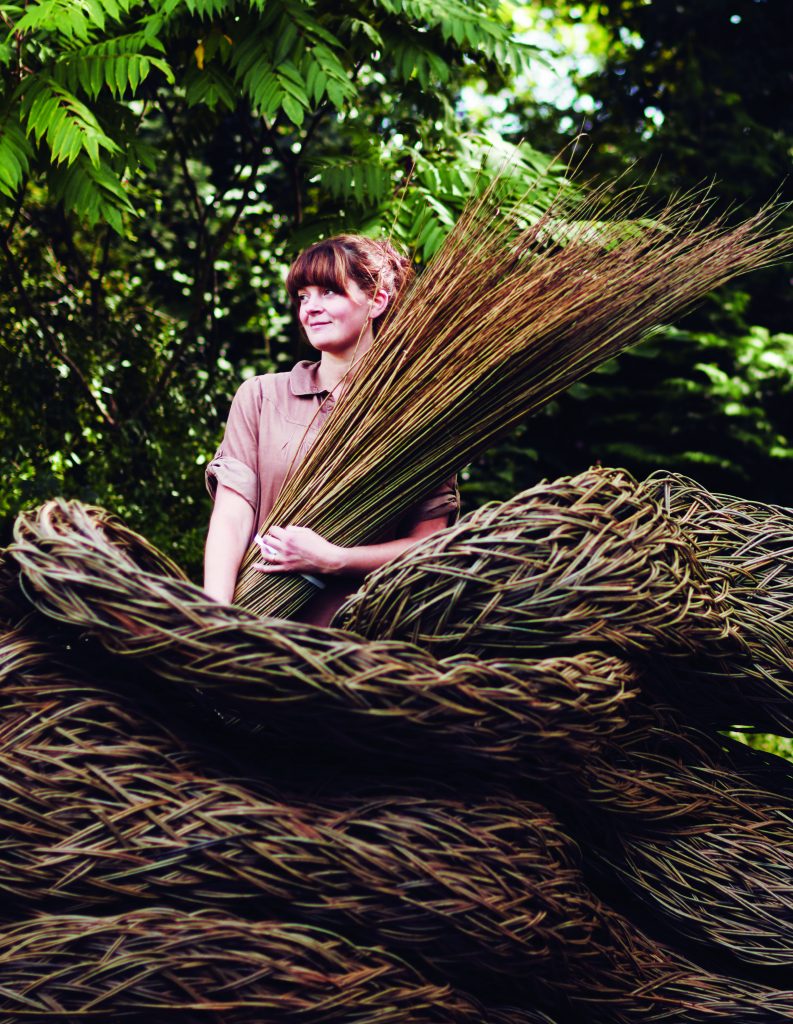
My sculptures are inspired by a deep-seated desire to make shapes and spaces that surround and envelope the body. All my shapes start off as forms you can get inside so the whole thing began with me moving sticks around and getting that thrill of “right, well I’ve just made that and I’m in it.” I trace this back to my childhood obsession with treehouses. Mum and Dad set up a fruit farm in the 1970s — in the good life days — and I was always outside like some feral child making dens and treehouses. Making a space to call my own was absolutely thrilling. But these outside spaces were not your common-or-garden den, but rather complex structures that I spent years creating. I had about four treehouses, and the biggest was a massive two-storey one built between five trees. It started off tiny and grew and grew. It was a complete mess but it was amazing to me and I was compelled to keep going and adding to it for years. I used wood sneaked from supplies provided by my joiner grandfather for my parents’ boiler as well as brushwood lying around the farm and, in a nod at things to come, old raspberry canes from the fruit farm. Although their texture is very different from willow, they are a similar length and size and I used them a lot.
I had no idea that this childhood obsession would lead to a career as a professional sculptor, although I happily did an art foundation course at Chesterfield College before going on to do a degree in applied arts at Derby University. I didn’t know what on earth I was going to do but thought I might end up working in a gallery. It wasn’t until my final year at university that something clicked. I told a tutor about the treehouses and explained about that huge creative fire I had when I was younger and how it had never been replaced by any other technique I had learned at college and he said, ‘OK, we need to work big then!’ Space was cleared for me and with my tutor’s encouragement, I moved my work from the confines of the desktop to a large area of floor. Here I started experimenting with making formed spaces inspired by memories of my childhood dens using tree branches delivered by my mother in car loads. The only problem was that I found I never had enough material to make what I wanted. I was using it up too fast and not making enough form, so in a bid to solve this problem I turned to willow.
It was a practical solution to a supply issue but was to prove a significant turning point in my creative journey. I could get willow in a large quantity and when I sniped the bundle open and all these sticks crashed to the floor, and I thought that was great—there’s something in this. Although my technique is often likened to basketry, I had no training in how to work willow but just knew that it was the right material for me. I felt I really wanted to knot this material together myself and work out how to join it and what those forms would generate. I just found my own ways to use it.
The making process I developed following this light-bulb moment is relatively simple, but highly effective. I start with two sticks at a time and build and build and build and eventually a framework appears. I liken the process to a creating a hatched drawing in which the form is built up with lots of tiny marks. I have to get a bit of structure and then I can bulk it up by weaving certain areas in to make it dense and hard and then carry on with the framework and tease it out. It’s quite random, you have to touch and feel it as you go—the work’s not built up with any set techniques. I am always thinking about form and I am always literally feeling a shape as it grows within the willow.
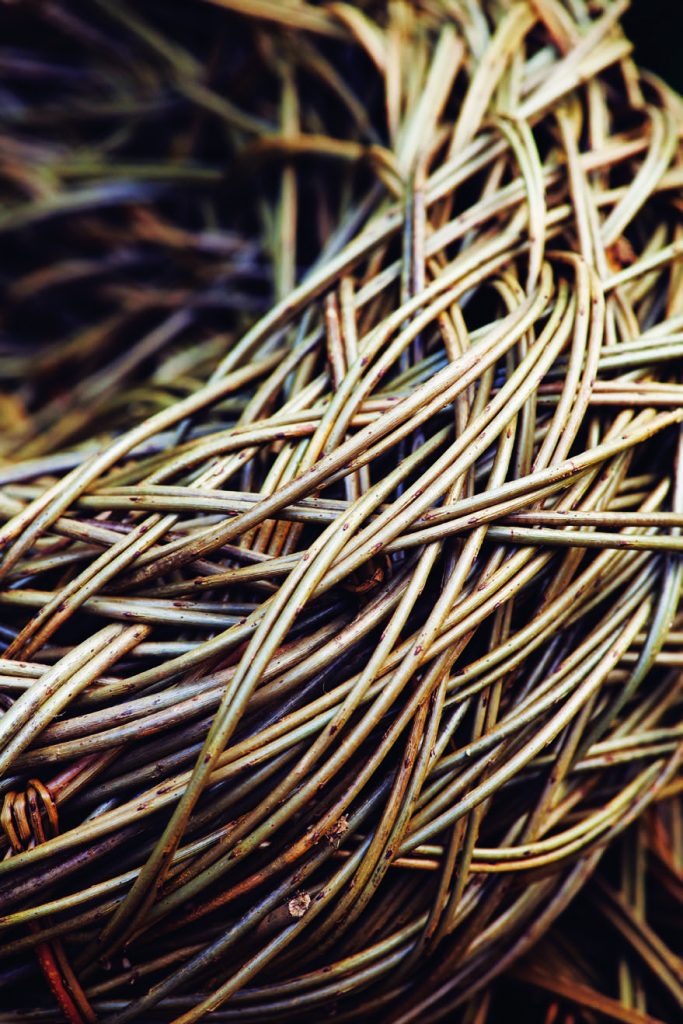
I taught myself how to join the willow together by a combination of knotting and weaving, although I am wary of the term ‘willow weaving.’ Willow weaving suggests ease of use and natural flow and something that is quite genteel, but my work isn’t like that as there’s lots of muscle involved—the willow has to be forced into place. I try to work with the natural properties of the willow, exploiting its flex and flow, but although willow is beautifully supple it doesn’t always behave as I want it to and sometimes has to be brutally manipulated into position. The work is all done by hand and whenever I am creating a sculpture I am just using my bare hands, handling the material and feeling the twist and flex of it.
I originally started using willow for purely technical reasons, not from a deep interest in ecology or a desire to use natural materials for their own sake. And in the past I have experimented with man-made fibres such as polypropylene in a bid to introduce colour to my work and to explore new possibilities and techniques. However, more recently my approach has changed, with a mixture of experience and education I have turned a corner and now make a deliberate choice to use natural materials. When things like willow are sustainably harvested I feel it’s a happier thing to do. The natural disorders are worth working with and make natural materials more appealing than something man-made.
I prize natural materials both for their allure and for their imperfections and blemishes.
The merging of my muscular forms with the linear lines of architecture is something that really appeals to me. But these pieces are not necessarily in harmony with the architecture, rather they may seem like an invasive species—imagine ivy growing on ruins—taking over a host building rather than an equal partnership. The form itself should basically appear to have grown for its own reason and that’s what makes it quite unsettling, as it should feel like it’s independent of the building and is just hanging on there for its own purpose.
One piece marks a new departure for me as it is made using thatch rather than willow. I’ve been given an Arts Council grant to experiment with this new material and have used it to make a giant sculpture which the viewer can enter and then experience the sensation of being immersed in the thatch. I wanted to create a structure that brings the thatching right around you rather than just being used as a topping. Although thatching is visually a long way from willow as it’s laid and runs smoothly in the same direction, it has the same sense of accumulation and density and that really appeals to me. I hope to continue my experiments with thatch next year as well as other different mediums.
I am a Derbyshire-based artist best known for my weird and wonderful willow sculptures. I make vast, amoeba-like forms, which curl and flow across gallery spaces or drip down walls like some intriguing alien growth with a life of its own. These organic shapes are strangely sensual and yet uncanny at the same time. Most are built up with individual sticks of willow, which I knot and weave and twist and pull using a random, intuitive technique I’ve developed. Close up, the sculptures are highly complex, with the individual strands of willow creating elaborate, baroque curlicues and scrolls deep within their body, but for me the pieces are really about their bold, sinuous shapes rather than the materials or techniques used in their making. The eye should be drawn to the outline of the whole form, but if you do look at the detail there should be a certain quality of line within the weave.

My sculptures are inspired by a deep-seated desire to make shapes and spaces that surround and envelope the body. All my shapes start off as forms you can get inside so the whole thing began with me moving sticks around and getting that thrill of “right, well I’ve just made that and I’m in it.” I trace this back to my childhood obsession with treehouses. Mum and Dad set up a fruit farm in the 1970s — in the good life days — and I was always outside like some feral child making dens and treehouses. Making a space to call my own was absolutely thrilling. But these outside spaces were not your common-or-garden den, but rather complex structures that I spent years creating. I had about four treehouses, and the biggest was a massive two-storey one built between five trees. It started off tiny and grew and grew. It was a complete mess but it was amazing to me and I was compelled to keep going and adding to it for years. I used wood sneaked from supplies provided by my joiner grandfather for my parents’ boiler as well as brushwood lying around the farm and, in a nod at things to come, old raspberry canes from the fruit farm. Although their texture is very different from willow, they are a similar length and size and I used them a lot.
I had no idea that this childhood obsession would lead to a career as a professional sculptor, although I happily did an art foundation course at Chesterfield College before going on to do a degree in applied arts at Derby University. I didn’t know what on earth I was going to do but thought I might end up working in a gallery. It wasn’t until my final year at university that something clicked. I told a tutor about the treehouses and explained about that huge creative fire I had when I was younger and how it had never been replaced by any other technique I had learned at college and he said, ‘OK, we need to work big then!’ Space was cleared for me and with my tutor’s encouragement, I moved my work from the confines of the desktop to a large area of floor. Here I started experimenting with making formed spaces inspired by memories of my childhood dens using tree branches delivered by my mother in car loads. The only problem was that I found I never had enough material to make what I wanted. I was using it up too fast and not making enough form, so in a bid to solve this problem I turned to willow.
It was a practical solution to a supply issue but was to prove a significant turning point in my creative journey. I could get willow in a large quantity and when I sniped the bundle open and all these sticks crashed to the floor, and I thought that was great—there’s something in this. Although my technique is often likened to basketry, I had no training in how to work willow but just knew that it was the right material for me. I felt I really wanted to knot this material together myself and work out how to join it and what those forms would generate. I just found my own ways to use it.
The making process I developed following this light-bulb moment is relatively simple, but highly effective. I start with two sticks at a time and build and build and build and eventually a framework appears. I liken the process to a creating a hatched drawing in which the form is built up with lots of tiny marks. I have to get a bit of structure and then I can bulk it up by weaving certain areas in to make it dense and hard and then carry on with the framework and tease it out. It’s quite random, you have to touch and feel it as you go—the work’s not built up with any set techniques. I am always thinking about form and I am always literally feeling a shape as it grows within the willow.

I taught myself how to join the willow together by a combination of knotting and weaving, although I am wary of the term ‘willow weaving.’ Willow weaving suggests ease of use and natural flow and something that is quite genteel, but my work isn’t like that as there’s lots of muscle involved—the willow has to be forced into place. I try to work with the natural properties of the willow, exploiting its flex and flow, but although willow is beautifully supple it doesn’t always behave as I want it to and sometimes has to be brutally manipulated into position. The work is all done by hand and whenever I am creating a sculpture I am just using my bare hands, handling the material and feeling the twist and flex of it.
I originally started using willow for purely technical reasons, not from a deep interest in ecology or a desire to use natural materials for their own sake. And in the past I have experimented with man-made fibres such as polypropylene in a bid to introduce colour to my work and to explore new possibilities and techniques. However, more recently my approach has changed, with a mixture of experience and education I have turned a corner and now make a deliberate choice to use natural materials. When things like willow are sustainably harvested I feel it’s a happier thing to do. The natural disorders are worth working with and make natural materials more appealing than something man-made.
I prize natural materials both for their allure and for their imperfections and blemishes.
The merging of my muscular forms with the linear lines of architecture is something that really appeals to me. But these pieces are not necessarily in harmony with the architecture, rather they may seem like an invasive species—imagine ivy growing on ruins—taking over a host building rather than an equal partnership. The form itself should basically appear to have grown for its own reason and that’s what makes it quite unsettling, as it should feel like it’s independent of the building and is just hanging on there for its own purpose.
One piece marks a new departure for me as it is made using thatch rather than willow. I’ve been given an Arts Council grant to experiment with this new material and have used it to make a giant sculpture which the viewer can enter and then experience the sensation of being immersed in the thatch. I wanted to create a structure that brings the thatching right around you rather than just being used as a topping. Although thatching is visually a long way from willow as it’s laid and runs smoothly in the same direction, it has the same sense of accumulation and density and that really appeals to me. I hope to continue my experiments with thatch next year as well as other different mediums.



